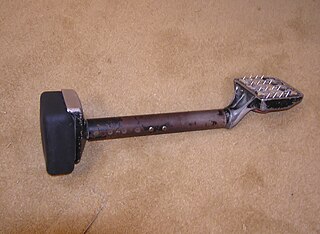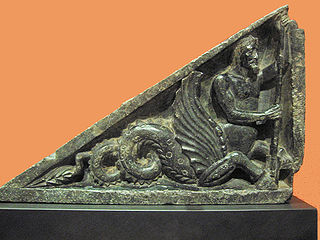Flooring is any a permanent covering of a floor, or the work of installing such a floor covering. Floor covering is a term to generically describe any finish material applied over a floor structure to provide a walking surface. Both terms are used interchangeably but floor covering refers more to loose-laid materials.

A stairway, staircase, stairwell, flight of stairs, or simply stairs, is a construction designed to bridge a large vertical distance by dividing it into smaller vertical distances, called steps. Stairs may be straight, round, or may consist of two or more straight pieces connected at angles.
A newel, also called a central pole or support column, is the central supporting pillar of a staircase. It can also refer to an upright post that supports the handrail of a stair banister. In stairs having straight flights it is the principal post at the foot of the staircase, but the term can also be used for the intermediate posts on landings and at the top of a staircase. Although its primary purpose is structural, newels have long been adorned with decorative trim and designed with different architectural styles.

The endpin or spike is the component of a cello or double bass that makes contact with the floor to support the instrument's weight. It is made of metal, carbon fiber, or, occasionally, wood, and is typically extensible from the bottom of the instrument, secured there with a thumbscrew or other tightening mechanism. Most bass clarinets and contrabassoons also have a similar fixture.

A stair lift is a mechanical device for lifting people up and down stairs. For sufficiently wide stairs, a rail is mounted to the treads of the stairs. A chair or lifting platform is attached to the rail. A person gets onto the chair or platform and is lifted up or down the stairs by the chair which moves along the rail.

Fifth Avenue–59th Street is a station on the BMT Broadway Line of the New York City Subway. Located under Grand Army Plaza near the intersection of 5th Avenue and 60th Street in Manhattan, it is served by the N train at all times, W on weekdays, and R at all times except late nights.

Atlantic Avenue–Barclays Center is a New York City Subway station complex shared by the BMT Fourth Avenue Line, the BMT Brighton Line and the IRT Eastern Parkway Line, located at Atlantic, Fourth, and Flatbush Avenues and Pacific Street in Downtown Brooklyn. The complex is served by the:

New Wardour Castle is an English country house at Wardour, near Tisbury in Wiltshire, built for the Arundell family. The house is of a Palladian style, designed by the architect James Paine, with additions by Giacomo Quarenghi, who was a principal architect of the Imperial Russian capital city Saint Petersburg.

The Family Dining Room is a dining room located on the State Floor of the White House, the official residence of the President of the United States. The room is used for smaller, more private meals than those served in the State Dining Room. Used in the 1800s as a space for the First Family to have their meals, the Family Dining Room was used less for family meals and more for working lunches and small dinners in the 20th and 21st centuries.

The Grand Staircase is the chief stairway connecting the State Floor and the Second Floor of the White House, the official home of the President of the United States. The stairway is primarily used for a ceremony called the Presidential Entrance March. The present Grand Staircase, the fourth staircase occupying the same general space, was completed in 1952 as a part of the Truman White House reconstruction. The Grand Staircase is entered on the State Floor from the Entrance Hall.

The West Sitting Hall is located on the second floor of the White House, home of the President of the United States. The room is entered from the second floor Center Hall on the east side of the room. The room features a large lunette window on the west wall looks out upon the West Colonnade, the West Wing, and the Old Executive Office Building. The room is used by first families as a less formal living room than the Yellow Oval Room.

The United States Post Office and Court House is a courthouse of the United States District Court for the Eastern District of Kentucky located in Lexington, Kentucky. Built in 1934, it was listed on the National Register of Historic Places in 1999.
In theatre, a platform is a stationary, standard flat walking surface for actors to perform on. Typically, they are built to be assembled modularly. They are often used to provide varying levels, to make a show more visually interesting. They are also used to separate areas on stage, and as seating bleachers. This is in contrast to scenery wagons, which are mobile platforms that are supported by casters instead of feet.

The Petit Luxembourg is a French hôtel particulier, currently the residence of the president of the French Senate. It is located at 17–17 bis, rue de Vaugirard, just west of the Luxembourg Palace, which currently serves as the seat of the Senate, in the 6th arrondissement of Paris. Originally built around 1550 to the designs of an unknown architect, it is especially noted for the surviving Rococo interiors designed in 1710–1713 by the French architect Germain Boffrand. Further west, at 19 rue de Vaugirard, is the Musée du Luxembourg.

A staircase timer is an electrical switch used to control lighting on a staircase, corridor or lobby. A single action turns on the lights and they remain on for long enough to ascend or descend the stairs. The lights then turn themselves off automatically.

Muswellbrook Post Office is a heritage-listed post office at 7 Bridge Street, Muswellbrook, New South Wales, Australia. It was added to the Australian Commonwealth Heritage List on 08 November 2011.
















